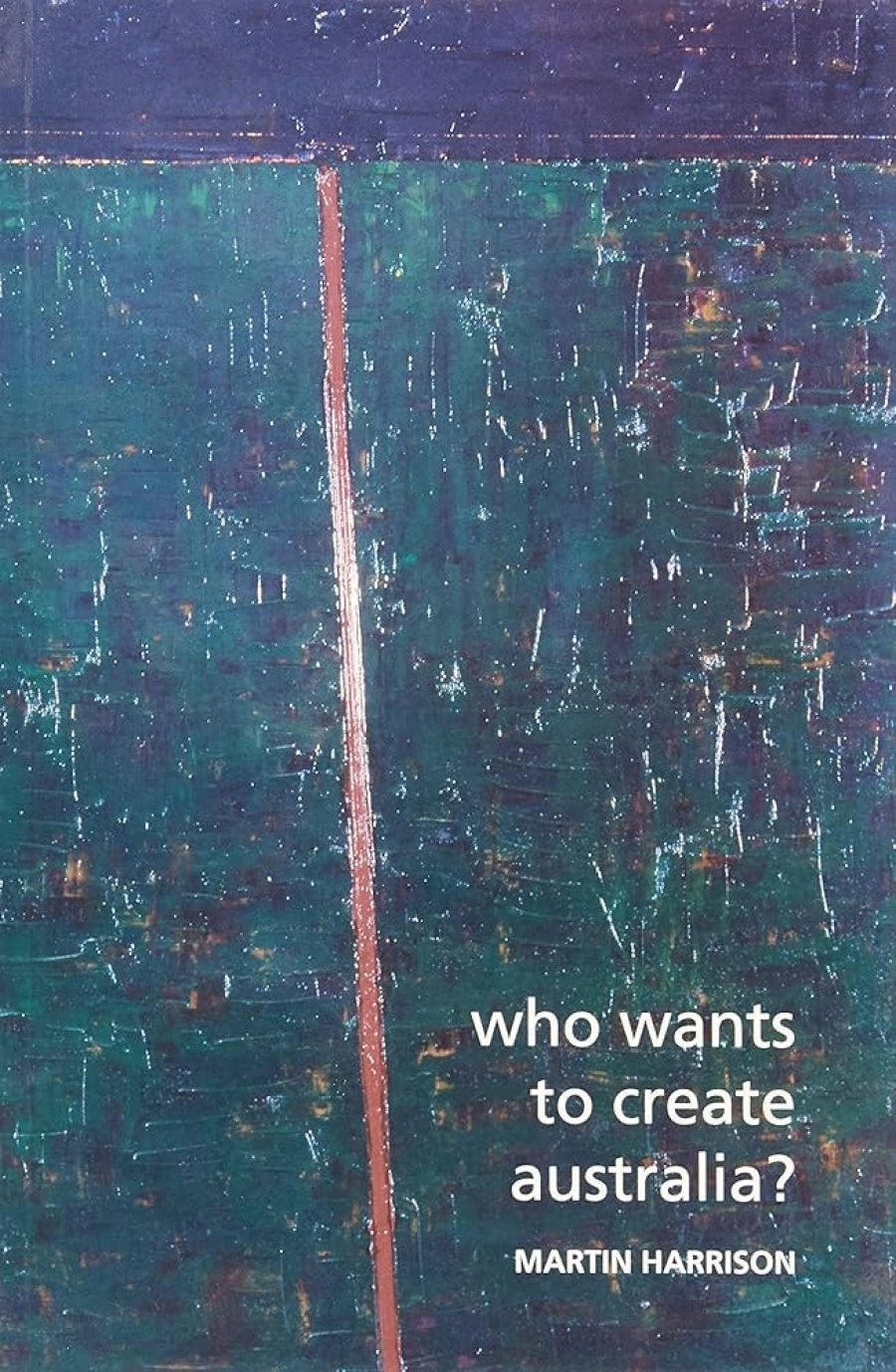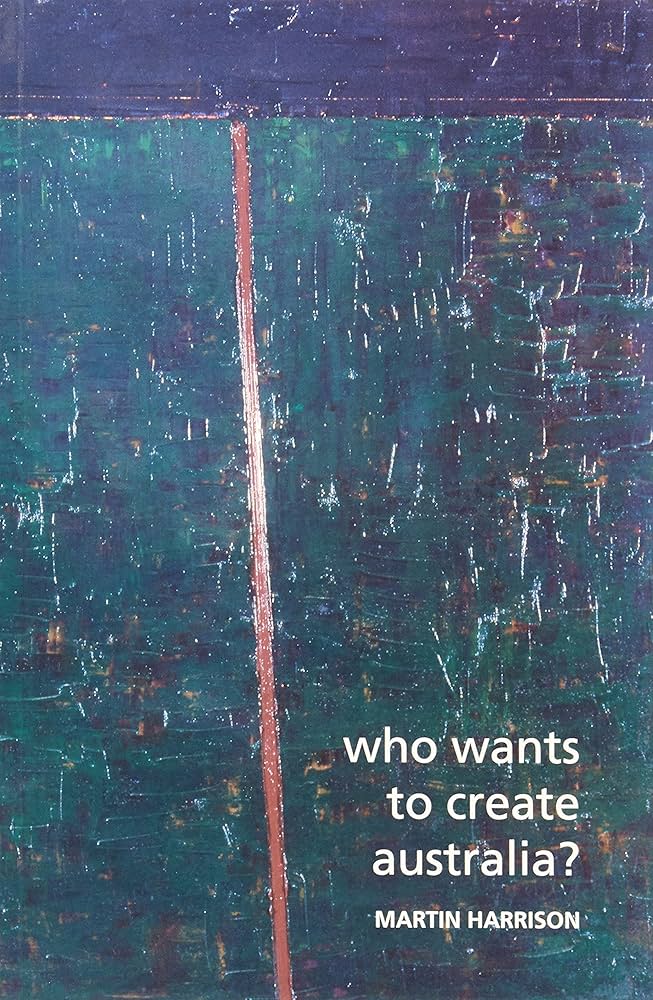
- Free Article: No
- Contents Category: Anthology
- Review Article: Yes
- Article Title: Meeting the Enemy
- Online Only: No
- Custom Highlight Text:
Martin Harrison’s poems have a fine discursive quality, which means that they often read like essays. Take ‘Midday’, from his recent volume Summer (2002), where a hand-scythe and the ABC radio news produce a meditation on time and place not dissimilar in its conclusion to that offered on several occasions in the essays included in Who Wants to Create Australia? ‘Only a little can be added to an everyday sense of life – / a singularity, a slowed-down look, faster than light, / a sense of movement out of nowhere, now, here.’
- Book 1 Title: Who Wants to Create Australia?
- Book 1 Subtitle: Essays on poetry and ideas in contemporary Australia
- Book 1 Biblio: Halstead Press, $29.95 pb, 112pp
- Book 1 Cover Small (400 x 600):

- Book 1 Cover (800 x 1200):

The essays can take some time to get to the point, but that, in a way, is their point. Poems are not easy to talk about. In his essay on Robert Gray, Harrison defines them as ‘reiterated meditational spaces’. ‘To engage with writing’s creative practices,’ he notes elsewhere, ‘is to address a complex, overlaid space where a multiplicity of experiences merge, start, stop, appear and disappear.’ Such spaces require complex modes of address, particularly since Harrison is concerned with their inner and outer limits, the subliminal and the sub-vocal in poetry, and the connections that hover on the edge of experience and understanding.
The essay on Gray typically focuses on liminal effects: here it is the poet’s habit of revising previously published poems for his New and Selected Poems (1998), ‘almost unnoticeably changing a word here, a word there, dropping a line or a half a line’. In such minute causes Harrison discerns profound effects, with an interest in ‘human presence and the darkness of human motive’ triumphing over the poet’s earlier commitment to ‘impersonal seeing’. For Harrison, Gray’s poetry already points towards something very much larger: ‘that slow shifting of continental purpose in turn of the millennium Australia, our re-thinking and re-positioning of ourselves … on the edge of South East Asia.’ With the supposed shift in his work from impersonality to human presence, from the object seen to the way in which it is seen, Harrison is able to enlist Gray, not only for humanism, but for a third important idea: the poem as an imaginative recreation of experience.
With such large issues at stake even in the poet’s simple changing of a word here and there, Harrison clearly has good reason to adopt a dramatic approach in his essays on poetry. The habit of striking large perspectives from small or transient details is a familiar gesture that invokes the sublime and that has its roots in romanticism. It cannot be a coincidence that the view of poetry Harrison advances in this collection of essays – the poem as recreating the moment of experience – is itself romantic in origin, as is the sense of place which he insists is an essential part of that moment, both for poet and reader.
The essayist’s stance, therefore, is all of a piece with that of the poet after all. But why be so dramatic about an aesthetic position that is so familiar as to be old-fashioned, and a commitment to place that might be found in Charles Harpur and Henry Kendall, if not with the Asian inflection found in Gray, or the chthonic and Christian convergences Harrison finds in Les Murray? There is another reason for the drama, and its name is Theory. Well, not only Theory but the contemporary associative logics of hypermedia and multimedia, digital recomposition and sampling – all those developments that attack the concept of individual creativity, or drive a wedge between experience and language, or deny the representational aspect of writing, or its intimate expression of voice and tone and feeling. Against such powerful enemies, with their philosophical sophistication and their technological mastery, Harrison notes, the work of the poet is likely to look ‘home-made, handcrafted, often small and mute’.
The need to keep the beast of Theory and its accomplices at bay should explain both the highly gestural nature of Harrison’s manner of argument and the apparently contradictory fact that it gestures towards poetic qualities so transient, so liminal, that they exist at the very edge of expressibility. This is what Theory cannot reach, something so vital and delicate that it might easily be lost to us forever. In Kevin Hart’s poetry, for example, Harrison discerns ‘a particular kind of attentiveness, or deep listening, staying ingrained in the mind just beneath threshold awareness as if it is being heard past the edge of ordinary perception’. Antigone Kefala operates ‘on the boundary of known and unknown areas of awareness’. And in illustration of ‘the adverbial trace’ that Harrison sees as registering the gap in all action between experience and its narrative, a poem by Murray offers its ‘shadow narrative’: ‘a story which is never fully tellable, whose recitation … is nuance and fragment.’
I like the sensitivity of this approach, but what I find most interesting in it – in Harrison’s conception of the poem as a space marked by crossings and convergences, in his talk of traces, boundaries and edges, in his invocation of liminal effects and multiple voices – is the fact that, for all his antagonism, he has clearly gone more than halfway towards meeting the enemy. His stance may seem old-fashioned, but the manner and direction of his thinking is thoroughly contemporary.


Comments powered by CComment